Brightness and Contrast Ratio
For the brightness (luminance), contrast, and color accuracy tests, we depend on a hardware colorimeter and software to help calibrate the displays. We use a Monaco Optix XR (DTP-94) colorimeter and Monaco Optix XR Pro software, and we also test with ColorEyes Display Pro. Results in nearly every case have been better with Monaco Optix XR Pro, so we only report the ColorEyes Display Pro results on the monitor evaluation pages. We'll start with a look at the range of brightness and contrast at the default LCD settings while changing just the brightness level. (In some cases, it will be necessary to reduce the color levels if you want to achieve a more reasonable brightness setting of 100 or 120 nits.)
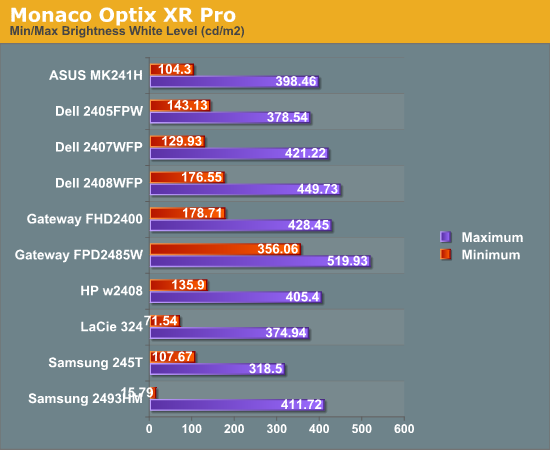
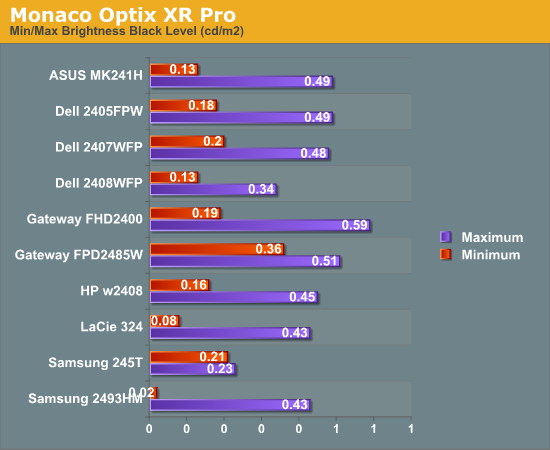
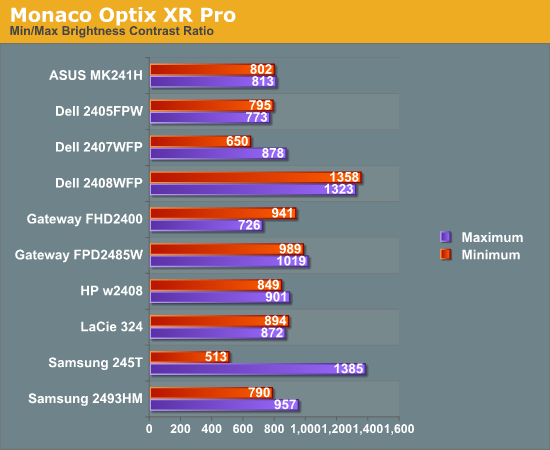
Nearly all of the LCDs have a maximum brightness level of around 400 nits, which is more than sufficient and is actually brighter than what most users prefer to use in an office environment. Minimum brightness without adjusting other settings is often above 100 nits, so it will be necessary to go in and adjust color levels as mentioned already. The Gateway FPD2485W is the prime example of this, where the default settings have a minimum brightness of 356 nits. Black levels are also reasonably consistent among the LCDs, with maximum and minimum black levels corresponding to the maximum and minimum white levels.
More important than the luminosity is the contrast ratio that is achievable at the various brightness settings. Here we begin to see some differences, with many of the LCDs following in the 800:1 ~ 900:1 range. The Dell 2408WFP and Samsung 245T stand out as having some of the highest contrast ratios, with the Dell taking the lead as it maintains the high contrast ratio even at low brightness settings. However, we should also mention that in practice the difference between 500:1 and 750:1 really isn't very significant for most users. It's only when you fall below 500:1 that colors really start to look washed out.
Color Gamut
We've already discussed color gamut of individual LCD evaluations, but it's a new addition to our LCD testing. This is something we wanted to add previously, but we lacked a good utility for generating the appropriate charts and data. We recently found out about Gamutvision, a utility developed by Imatest LLC. They were kind enough to provide us with a copy of their software, and it does exactly what we need. We compared the color profiles of all previously tested LCDs to the Adobe RGB 1998 color profile. Graphs of the individual gamut volumes are available on the evaluation pages. Below is a chart showing the percentage of the Adobe RGB 1998 gamut from the various displays.
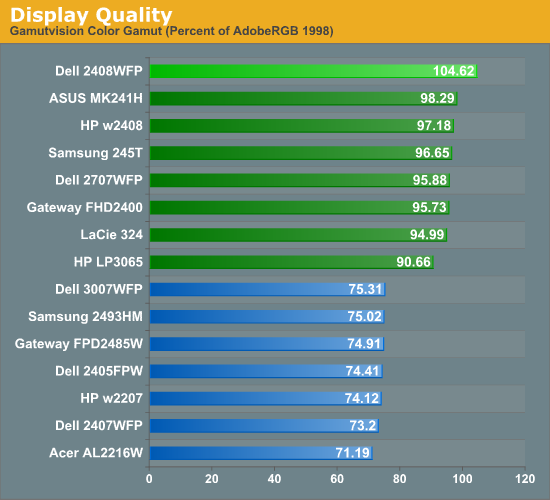
We basically end up with two tiers of quality in terms of color gamut. Filling the bottom tier are mostly older displays that have 82% NTSC color gamut backlighting. These may seem drastically inferior to the newer LCDs, but keep in mind that if you are just using the standard sRGB profile these LCDs look fine. It's only when you work in applications like Adobe Photoshop with its improved color space that you begin to notice a difference between the displays. Most of the newer displays now have ~95% Adobe RGB color gamuts, and the Dell 2408WFP actually surpasses the Adobe RGB 1998 color space. The only display in this round up that doesn't make it into the upper tier is the Samsung 2493HM.
Power Requirements
Another new test we decided to add with this roundup is a quick look at power requirements. Like the above tests, power requirements are checked at default LCD settings while varying the brightness setting. Also note that minimum power requirements are going to depend largely on how dim the backlight is at the minimum setting, so looking at the above charts it shouldn't be difficult to figure out that the Samsung 2493HM will require less power than the others when it's only putting out 16 lumens.
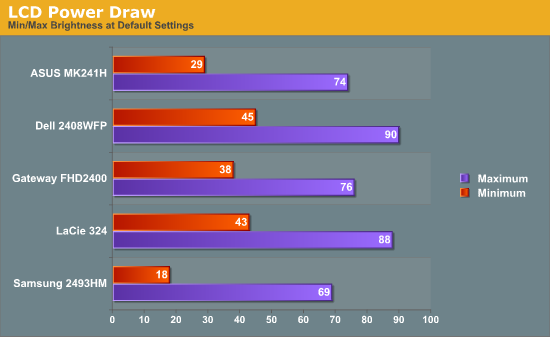
We've only begun collecting this data with this batch of LCDs, so we don't have any clear patterns established yet. However, it's interesting to note that the two S-PVA panels to seem to draw slightly more power than the three TN panels. At equivalent brightness settings, the differences in power draw are very small.










89 Comments
View All Comments
Rasterman - Friday, May 9, 2008 - link
Yeah the figures reported are meaningless, if they were actually useful we wouldn't even need reviews :) I can't believe that a company as big as Viewsonic doesn't send a review site as big as Anandtech a review model, that is just ridiculous, they should be sending you guys a new model of every new monitor without even asking, maybe you aren't emailing the right person. BTW its awesome to see a reviewer actually answer questions and critics to a review, awesome job Jarred!JarredWalton - Friday, May 9, 2008 - link
I'm sure I'm not getting the right person at Viewsonic (and other companies as well), but that's the trick: *finding* the right person. Without an inside contact, it can be tough to get started.Generic PR Person: "AnandTech? What kind of a name is that? http://www.homestarrunner.com/sbemail50.html">Baleeted!" I'll try to meet with them next CES or something....
PS - Anyone from Viewsonic read this? If so, email me! :-)
10e - Tuesday, May 6, 2008 - link
Great review. This is what multifunction fans are looking for. I had this issue a year ago trying to find "THE" multifunction.You may want to mention that in terms of 720p and 1080p the Samsung stretches both to 16:10 with A/V mode off. I tested this and found that problem recently, which was unfortunate due to the fact that I liked it as a high quality TN.
JarredWalton - Tuesday, May 6, 2008 - link
I mentioned this on page 11, but I have highlighted (italicized) the pertinent text. I also clarified by indicating that 16:9 modes will always have the wrong AR. Thanks for reading and commenting!xerces8 - Monday, May 5, 2008 - link
A picture says more than 1000 words :http://www.digitalversus.com/duels.php?ty=6&ma...">http://www.digitalversus.com/duels.php?...2=49&...
(I can't create a link, seems the post javascript is broken, I cant make bold or italics text either, tried FF and IE7)
JarredWalton - Monday, May 5, 2008 - link
You mean, http://www.digitalversus.com/duels.php?ty=6&ma...">pictures like this one? I don't see any large blowups of their comparisons available for download, so I have no idea exactly how they're testing. What I do know is that I provided images showing LaCie 324 and Dell 2408WFP clearly displaying a 40ms delay relative to an HP LP3065, and I've also provided a picture of the ASUS MK241H with a relative delay of 0ms relative to the same LCD.I've got nine other sample images from each of the tested monitors showing the evidence for my "input lag" conclusions. That's about as close to full disclosure as you'll get. All I get on that comparison you linked is a chart that apparently "proves" the ASUS MK241H has a 54ms average delay compared to a CRT, but then the same site lists the Dell 2408WFP as 69ms, the 2407WFP as 24ms, the LaCie as 41ms, and the Samsung 245T at 59ms. I got more or less the same result on the Dell 2407WFP and the LaCie 324, but nowhere near the same result on the MK241H, 2408WFP, and the 2493HM.
Again, you've got at least one clear sample of my results for each LCD. Sorry, but I have to question their results without better evidence.
Dashel - Monday, May 5, 2008 - link
Hi Jarred,Not sure if this is based on the same test or what but there is this:
http://www.behardware.com/art/imprimer/712/">http://www.behardware.com/art/imprimer/712/
Which looks to be the same graph and results. To me your results seem to make the most sense if the 2408 is very similar to the 2407WFP-HC, then the input lag should be close too I would guess. I'm hardly an expert just tryint to be logical.
The thing is I also see anecdotal claims of lag and people who have tested it getting in the 60ms range as well which leads me to wonder if there isnt some sort of defect or difference in some of the panels vrs others.
Example of a test by an owner:
http://www.hardforum.com/showpost.php?p=1032124531...">http://www.hardforum.com/showpost.php?p=1032124531...
I'd love to hear Dells thoughts on it as well as what and when their revision is due to hit.
JarredWalton - Monday, May 5, 2008 - link
I'd like to know what software people are using as timers. I tried about 10 different "timers" and discovered that a bunch are limited to the Windows default timing resolution - about 54ms. So they either scored "0ms" or "54ms" on the delay. I know this because I had screen refreshes where the timer was split in half; the top half would show for example 40.067 and the bottom would show 50.121.3DMark03 at least looks to be accurate down to 10ms - there are again pictures where the timer is cut in half, only in such cases I would see 20.23 and 20.24, so I can be sure that the timer is updated in .01s increments rather than in something larger.
Without a lot more details about what software people use and large images showing the results, I must say that I'm very skeptical. I feel "input lag" testing needs several things to be even remotely acceptable:
1) Run at native LCD resolution in clone mode (because built-in scalers could have an impact)
2) Disclosure of the test software that manages better than 54ms accuracy.
3) You need a high-end camera with a fast shutter speed to capture the results. Simply choosing "Auto" mode and snapping a picture doesn't tell the whole story.
4) Provide at least one sample image at a high resolution that clearly shows what the camera captured.
I met all of those criteria I think. In looking around at other reviews, I have not been able to clearly answer any of those questions. Perhaps that's why some of the other results are so different. I also tested at 2560x1600 to verify that I wasn't hurting the HP LP3065 by running at a lower resolution; since the scaling is handled by the GPU rather than the LCD (the LP3065 doesn't have a scaler), there was no penalty.
DangerousQ - Monday, May 5, 2008 - link
I cant believe this set of reviews is so one sided, why no P-MVA panels, I bought a BenQ FP241W about 3 monyths ago and the 6ms response time plus unbelievable colours make this panel really hard to beat, but you try finding any reviews on it. The one review I did find, a long time ago and have lost it now compared it to the 2407 dell and found it a better panel for less money! I know this cos I was going to buy the dell before I saw the review.JarredWalton - Monday, May 5, 2008 - link
Send me an MVA panel - or get one of the manufacturers to send me one - and I will be more than happy to review it. I don't have the means to go out and purchase $500+ test LCDs, so I review what I get sent. Dell, Gateway, Samsung, ASUS, and other major companies are great about working with review sites like ours. Other companies are not. Thus, I take what I can get.